Structure and Dynamics of Solar Atmosphere
Web pages of astronomical working group
Menu
Reconstruction of the Coimbra spectroheliograph
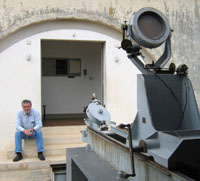 The acquisition of spectroheliograms
at the Astronomical Observatory of the Coimbra University (Portugal) has a long tradition.
In a close collaboration with the Meudon Observatory, a classical spectroheliograph was built and
put in operation in 1926. The full-disc spectroheliograms were registered on photographic
emulsions in the spectral lines H-alpha, CaII-K3, and CaII-K1. Systematic observations have been
carried out in Coimbra without any interruption since the commissioning of the instrument.
The acquisition of spectroheliograms
at the Astronomical Observatory of the Coimbra University (Portugal) has a long tradition.
In a close collaboration with the Meudon Observatory, a classical spectroheliograph was built and
put in operation in 1926. The full-disc spectroheliograms were registered on photographic
emulsions in the spectral lines H-alpha, CaII-K3, and CaII-K1. Systematic observations have been
carried out in Coimbra without any interruption since the commissioning of the instrument.
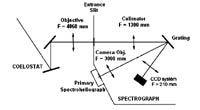 Optical system of the spektroheliograph.
The objective lens of the horizontal telescope has focal length F = 4060 mm
and diameter 250 mm. The telescope is fed by two coelostat mirrors with diameters 320 mm.
The maximum diameter of the solar disc on the spectrograph entrance slit is 38.5 mm.
The spectrograph consists of a collimator lens (F = 1300 mm, diameter 150 mm),
a camera lens (F = 3000 mm, diameter 132 mm), and a reflectional diffraction grating
with 300 grooves per milimeter. The figure shows the optical scheme of the
telescope and spectrograph with the newly installed CCD system.
Optical system of the spektroheliograph.
The objective lens of the horizontal telescope has focal length F = 4060 mm
and diameter 250 mm. The telescope is fed by two coelostat mirrors with diameters 320 mm.
The maximum diameter of the solar disc on the spectrograph entrance slit is 38.5 mm.
The spectrograph consists of a collimator lens (F = 1300 mm, diameter 150 mm),
a camera lens (F = 3000 mm, diameter 132 mm), and a reflectional diffraction grating
with 300 grooves per milimeter. The figure shows the optical scheme of the
telescope and spectrograph with the newly installed CCD system.
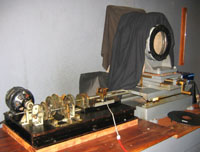 Properties of the spektroheliograph.
The spektroheliograph is constructed with a great precision. All factors that influence the correct
imaging of the solar disc are compensated. Spectroheliograms in H-alpha and CaII-K lines can be
acquired (using different pre-filters) without the necessity to change the angle of the diffraction
grating. The motion of solar disc across the entrance slit of the spectrograph is realized
by the motion of the telescope's objective lens (see figure).
Properties of the spektroheliograph.
The spektroheliograph is constructed with a great precision. All factors that influence the correct
imaging of the solar disc are compensated. Spectroheliograms in H-alpha and CaII-K lines can be
acquired (using different pre-filters) without the necessity to change the angle of the diffraction
grating. The motion of solar disc across the entrance slit of the spectrograph is realized
by the motion of the telescope's objective lens (see figure).
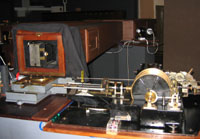 This figure shows the movable exit slit of the spectroheliograph (left) that can be used
for classical photographic measurements. Top right in the background, above the driving
mechanism of the slit, is seen the new CCD camera.
This figure shows the movable exit slit of the spectroheliograph (left) that can be used
for classical photographic measurements. Top right in the background, above the driving
mechanism of the slit, is seen the new CCD camera.
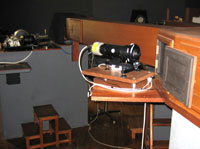 Recently, a requirement to replace the photographic emulsion by a
CCD detector has appeared. The reason is the direct digitization of
measurements, enabling a more sophisticated data processing. The original
optical system of the spectroheliograph was extended, adding a new optical path
including pre-filters, an optical system with variable focal length 200-240 mm, and
the CCD camera CCD-1300LN produced by
VDS Vosskühler GmbH (see figure).
This solution preserved the functions of the original spectroheliograph and made it
possible to reconstruct the instrument without any interruption in the observations.
Recently, a requirement to replace the photographic emulsion by a
CCD detector has appeared. The reason is the direct digitization of
measurements, enabling a more sophisticated data processing. The original
optical system of the spectroheliograph was extended, adding a new optical path
including pre-filters, an optical system with variable focal length 200-240 mm, and
the CCD camera CCD-1300LN produced by
VDS Vosskühler GmbH (see figure).
This solution preserved the functions of the original spectroheliograph and made it
possible to reconstruct the instrument without any interruption in the observations.
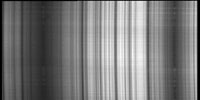 The application of CCD chips in astronomical instruments that were designed originally for the
registration on photographic emulsions is sometimes problematic. The problems get more serious
when the full solar disc is observed and digitized. A strong curvature of spectral lines
led the designers of the original spectroheliograph to the usage of curved entrance and
exit slits. The figure shows an example of curved spectral lines in the region of calcium
lines CaII-K and CaII-H.
The application of CCD chips in astronomical instruments that were designed originally for the
registration on photographic emulsions is sometimes problematic. The problems get more serious
when the full solar disc is observed and digitized. A strong curvature of spectral lines
led the designers of the original spectroheliograph to the usage of curved entrance and
exit slits. The figure shows an example of curved spectral lines in the region of calcium
lines CaII-K and CaII-H.
The registration of a spektroheliogram is done in two steps.
First, during the motion of the solar disc across the entrance slit of the spectroheliograph,
spectra are digitized in real time (software CAMAC). Individual spectra differ in the
position of the entrance slit on the solar disc. In the second step, the spectra are
processed to obtain the resulting spectroheliogram. The spectra are calibrated using dark
current and flat field and corrected for the curvatures of spectral lines and of the entrance
slit. Vertical columns corresponding to the selected wavelengths are extracted from the
corrected spectra and composed to form the spectroheliogram
(software ADRIAN30).
We can see that the composition of a spectroheliogram is the same as is done with
a classical photographic spectroheliograph. The difference is in the possibility
to select an arbitrary wavelength inside the range of the digitized spectrum. This
advantage can be taken for the measurement of Doppler velocities, which was not
possible to do with the original spectroheliograph
(software ADRIDL04).
Different transfer tables are utilized for the optimal visualization of spectroheliograms.
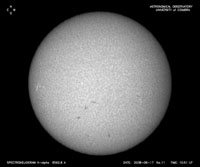 The resulting spectroheliograms are stored in the JPEG format for a visual inspection
and in the FITS format for further analysis. The figure shows the solar disc
observed on 17 June 2008 in the H-alpha line centre.
The resulting spectroheliograms are stored in the JPEG format for a visual inspection
and in the FITS format for further analysis. The figure shows the solar disc
observed on 17 June 2008 in the H-alpha line centre.
Reference:
Klvana, M., García, A., Bumba, V., 2007,
The modernized spectroheliograph at Coimbra,
in The Physics of Chromospheric Plasmas (P. Heinzel, I. Dorotovic, and R. Rutten, eds.),
ASP Conference Series, Vol. 368, 549-558.